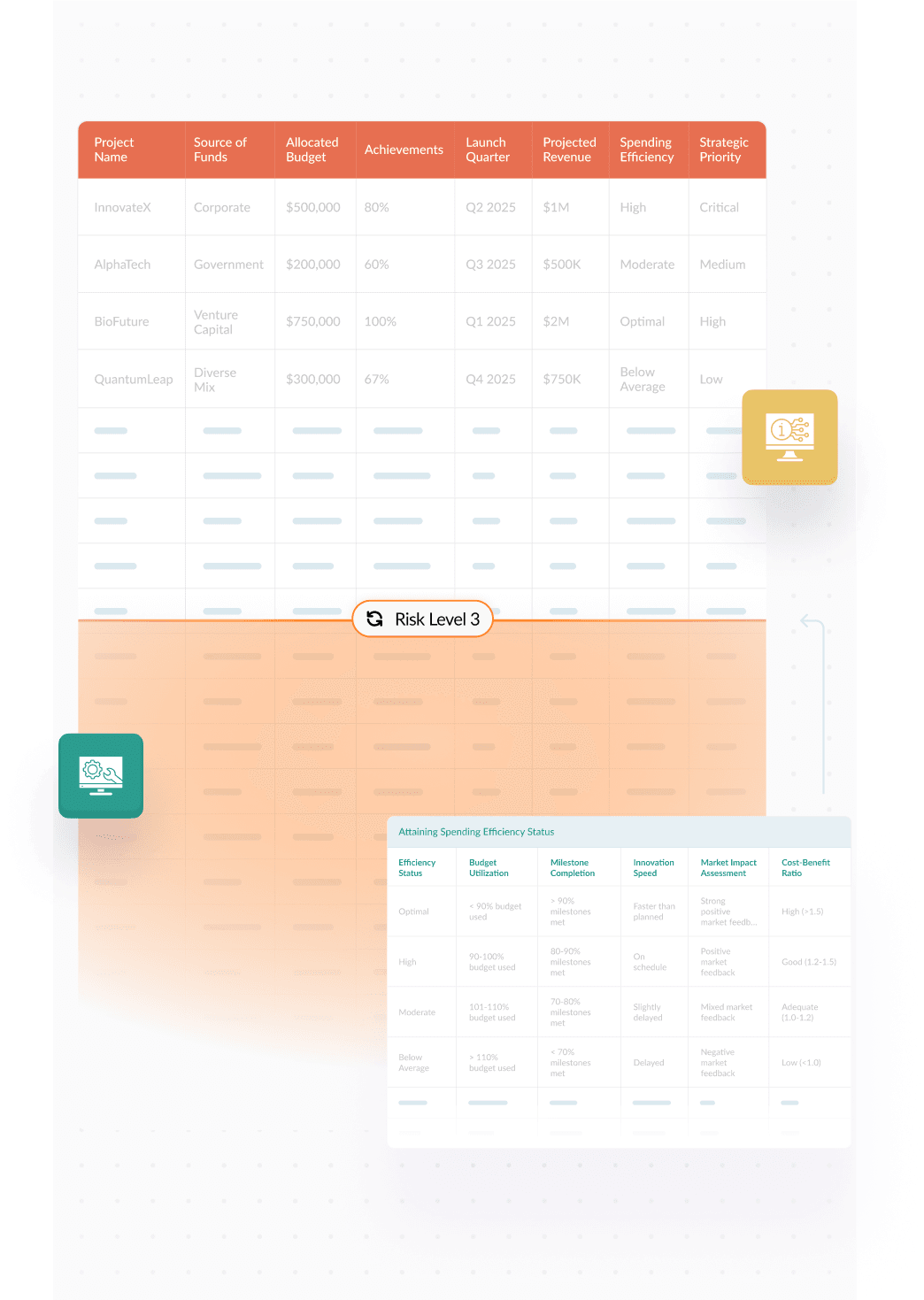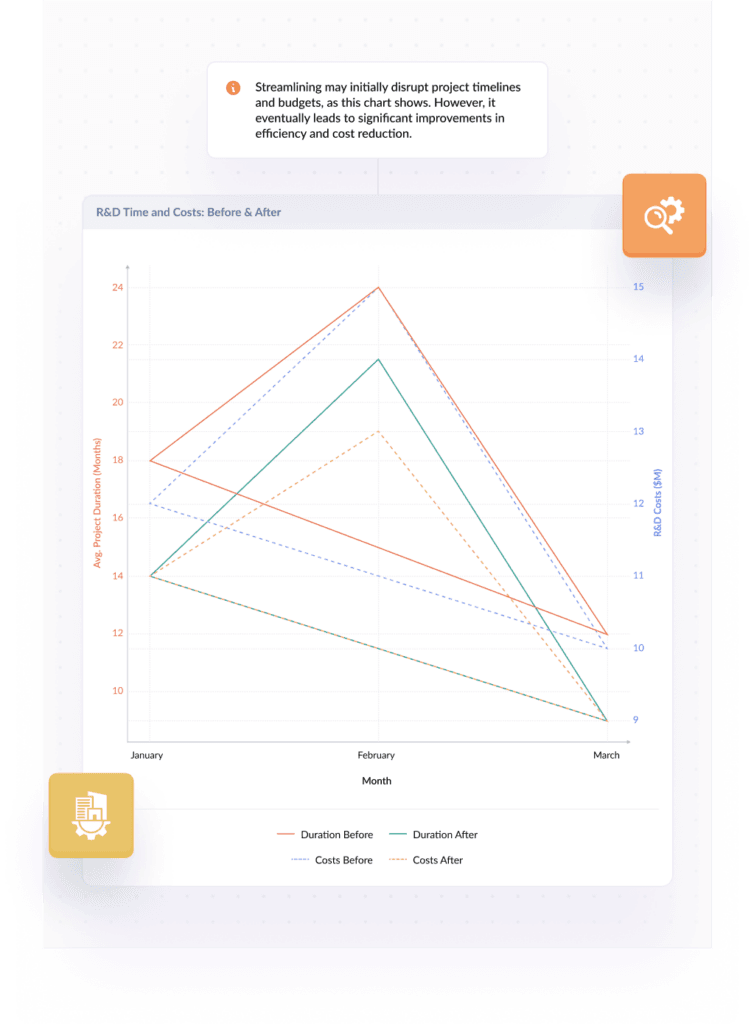Research and Development (R&D)
Innovation and Development of New Products and Services

Financial & Capital Analytics
R&D Spending Efficiency: Analyze the efficiency of R&D spending by comparing budget allocations against milestones and deliverables in projects. Assess how spending impacts innovation outcomes and time to market for new products
Cost of Innovation Analysis: Evaluate the total cost of developing new products or services, including labor, technology, and materials. Understand how these costs correlate with successful market entry and revenue generation
Funding Sources and Allocation: Scrutinize the mix of funding sources for R&D activities, including internal funding, public grants, and private investments. Assess the effectiveness of funding allocation among various R&D projects
Project Prioritization and Selection: Optimize the R&D portfolio by evaluating the potential market impact, revenue generation, and strategic fit of various innovation projects. Prioritize projects based on financial and strategic criteria
Technology Investment Analysis: Balance investments in cutting-edge technologies against their potential to drive breakthrough innovations. Assess the financial return on investment from technology acquisitions or development
Emerging Technological Trends: Conduct market research on emerging trends and technologies that could impact future R&D directions. Analyze potential financial returns from investing in these new technologies
Competitive Innovation Benchmarking: Engage in detailed benchmarking of competitors’ R&D spending and output. Identify gaps in the market that can be filled with innovative products or services
Innovation Lifecycle Financial Modeling: Develop financial models that map the lifecycle of innovation from concept to commercialization. Include cost projections, potential revenue streams, and break-even analysis
Risk and Return Projections: Create models to estimate the risk and potential returns of R&D projects. Factor in variables such as market acceptance, production scalability, and competition
Strategic Investment in R&D: Identify the best strategies for financing R&D efforts, including equity investments, reinvestment of profits, and strategic partnerships
Valuation of Intellectual Property (IP): Develop methodologies for valuing IP generated from R&D activities. Consider the financial implications of patenting versus other forms of IP protection
Project Budget Variance: Monitor and manage variances between projected and actual budgets for R&D projects. Identify causes of variances and adjust funding or project scopes accordingly
Innovation Output Variance: Analyze discrepancies between expected and actual innovation outputs. Adjust project management practices and resource allocation to improve R&D efficiency
Technology Adoption Risks: Evaluate the risks associated with adopting new technologies within R&D processes. Develop risk mitigation strategies that minimize financial losses and project delays
Market Uncertainty and Innovation Risks: Assess the financial risks posed by market uncertainty on the success of new innovations. Develop contingency plans to manage risks related to customer acceptance and market penetration
Acquisition of Innovative Startups: Analyze potential M&A opportunities with startups or other R&D-intensive companies to accelerate innovation. Evaluate financial, technological, and market synergies
Strategic Divestitures of R&D Units: Assess the financial benefits and strategic implications of divesting non-core R&D units. Model the impact of such divestitures on the overall financial health and innovation capacity
Process Mining
Secure data related to innovation processes, project timelines, and outcome evaluations in R&D activities
Clarify this data, refining it to reflect accurately the innovation pipeline and developmental milestones
Sketch models of research projects and development processes to trace workflows and innovation efficiency
Audit the alignment of R&D activities with strategic goals and regulatory compliance, pinpointing areas for process refinement
Boost innovation efficiency, enhance project management, and fine-tune product development cycles using detailed R&D insights


Business Intelligence
Summarize project timelines, investment levels, and innovation outcomes to gauge productivity and effectiveness in R&D efforts
Analyze reasons for project delays or failures by examining R&D processes, resource allocation, and collaboration effectiveness
Use historical project data and innovation trends to forecast the potential success of new R&D projects and identify promising innovation areas
Recommend adjustments in project scopes or resource deployment based on predictive insights to enhance the likelihood of successful innovation
Integrate data from past projects, market feedback, and technological advancements to infer underlying patterns and drive future R&D strategy
Streamlining
Analyze the R&D lifecycle from conceptualization to testing and final product development. Identify process bottlenecks such as lengthy approval times, inadequate resource allocation, or inefficient collaboration between teams
Utilize project management tools to streamline project tracking and automate routine tasks in the research process. Implement data analysis software to speed up experimental data processing
Use metrics like project timelines, budget adherence, patent filings, and innovation rates to measure R&D productivity and effectiveness
Merge similar research teams or projects to pool resources, share expertise, and enhance collaborative innovation efforts
Develop standardized protocols for experimental procedures, documentation, and reporting to enhance reproducibility and reliability of research outcomes
Establish feedback systems involving peer reviews, industry partnerships, and academic collaborations to foster open innovation and continuous improvement in research methods
Assess R&D strategies and projects to determine their impact on advancing knowledge, creating marketable products, or improving existing solutions. Refine R&D focus and resource allocation based on these findings

